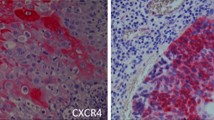Abstract
Expression of the CXCL12/CXCR4 chemokine axis has been related with the appearance of metastatic recurrence survival, including regional and distant recurrence, in patients with head and neck squamous cell carcinoma (HNSCC). RT-PCR was used to determine mRNA expression levels of CXCL12 and CXCR4 in biopsy tumor samples in 111 patients with HNSCC. Five-year regional recurrence-free survival for patients with low CXCR4 expression (n = 39, 31.5 %) was 97.4 %, for patients with high CXCR4/high CXCL12 expression (n = 22, 19.8 %) it was 94.7 %, and for patients with high CXCR4/low CXCL12 expression (n = 50, 45.0 %) it was 63.3 %. We found significant differences in the regional recurrence-free survival according to CXCR4/CXCL12 expression values (P = 0.001). HNSCC patients with high CXCR4 and low CXCL12 expression values had a significantly higher risk of regional recurrence and could benefit from a more intense treatment of lymph node areas in the neck.





Similar content being viewed by others
References
Layland MK, Sessions DG, Lenox J (2005) The influence of lymph node metastasis in the treatment of squamous cell carcinoma of the oral cavity, oropharynx, larynx, and hypopharynx: N0 versus N+. Laryngoscope 115:629–639
Vergeer MR, Doornaert PA, de Bree R, Leemans CR, Slotman BJ, Langendijk JA (2011) Postoperative elective nodal irradiation for squamous cell carcinoma of the head and neck: outcome and prognostic factors for regional recurrence. Ann Oncol 22:2489–2494
Olsen KD, Caruso M, Foote RL et al (1994) Primary head and neck cancer. Histopathologic predictors of recurrence after neck dissection in patients with lymph node involvement. Arch Otolaryngol Head Neck Surg 120:1370–1374
Mamelle G, Pampurik J, Luboinski B, Lancar R, Lusinchi A, Bosq J (1994) Lymph node prognostic factors in head and neck squamous cell carcinomas. Am J Surg 168:494–498
Kowalski LP, Bagietto R, Lara JR, Santos RL, Silva JF Jr, Magrin J (2000) Prognostic significance of the distribution of neck node metastasis from oral carcinoma. Head Neck 22:207–214
Wenzel S, Sagowski C, Kehrl W, Metternich FU (2004) The prognostic impact of metastatic pattern of lymph nodes in patients with oral and oropharyngeal squamous cell carcinomas. Eur Arch Otorhinolaryngol 261:270–275
de Juan J, García J, López M et al (2013) Inclusion of extracapsular spread in the pTNM classification system: a proposal for patients with head and neck carcinoma. JAMA Otolaryngol Head Neck Surg 139:483–488
An SY, Jung EJ, Lee M et al (2008) Factors related to regional recurrence in early stage squamous cell carcinoma of the oral tongue. Clin Exp Otorhinolaryngol 1:166–170
Uchida D, Onoue T, Tomizuka Y et al (2007) Involvement of an autocrine stroma cell derived factor-1/CXCR4 system on the dist metastasis of human oral squamous cell carcinoma. Mol Cancer Res 5:685–694
Almofti A, Uchida D, Begum NM et al (2004) The clinicopathological significance of the expression of CXCR4 protein in oral squamous cell carcinoma. Int J Oncol 25:65–71
Ishikawa T, Nakashiro K, Hara S et al (2006) CXCR4 expression is associated with lymph-node metastasis of oral squamous cell carcinoma. Int J Oncol 28:61–66
Ueda M, Shimada T, Goto Y et al (2010) Expression of CC-chemokine receptor 7 (CCR7) and CXC-chemokine receptor 4 (CXCR4) in head and neck squamous cell carcinoma. Auris Nasus Larynx 37:488–495
Clatot F, Gouérant S, Mareschal S et al (2014) The gene expression profile of inflammatory, hypoxic and metabolic genes predicts the metastatic spread of human head and neck squamous cell carcinoma. Oral Oncol 50:200–207
León X, Orús C, Quer M (2002) Design, maintenance, and exploitation of an oncologic database for patients with malignant tumors of the head and neck. Acta Otorrinolaringol Esp 53:185–190
Tan CT, Chu CY, Lu YC et al (2008) CXCL12/CXCR4 promotes laryngeal and hypopharyngeal squamous cell carcinoma metastasis through MMP-13 dependent invasion via the ERK1/2/AP-1 pathway. Carcinogenesis 29:1519–1527
Katayama A, Ogino T, Bandoh N, Nonaka S, Harabuchi Y (2005) Expression of CXCR4 and its down-regulation by IFN-gamma in head and neck squamous cell carcinoma. Clin Cancer Res 11:2937–2946
Lee JI, Jin BH, Kim MA, Yoon HJ, Hong SP, Hong SD (2009) Prognostic significance of CXCR-4 expression in oral squamous cell carcinoma. Oral Surg Oral Med Oral Pathol Oral Radiol Endod 107:678–684
Albert S, Hourseau M, Halimi C et al (2012) Prognostic value of the chemokine receptor CXCR4 and epithelial-to-mesenchymal transition in patients with squamous cell carcinoma of the mobile tongue. Oral Oncol 48:1263–1271
Clatot F, Picquenot JM, Choussy O et al (2011) Intratumoural level of SDF-1 correlates with survival in head and neck squamous cell carcinoma. Oral Oncol 47:1062–1068
Uchida D, Begum NM, Almofti A et al (2003) Possible role of stromal-cell-derived factor-1/CXCR4 signaling on lymph node metastasis of oral squamous cell carcinoma. Exp Cell Res 290:289–302
Samara GJ, Lawrence DM, Chiarelli CJ et al (2004) CXCR4-mediated adhesion and MMP-9 secretion in head and neck squamous cell carcinoma. Cancer Lett 214:231–241
Rehman AO, Wang CY (2008) SDF-1alpha promotes invasion of head and neck squamous cell carcinoma by activating NF-kappaB. J Biol Chem 283:19888–19894
Uchida D, Begum NM, Tomizuka Y et al (2004) Acquisition of lymph node, but not distant metastatic potentials, by the overexpression of CXCR4 in human oral squamous cell carcinoma. Lab Invest 84:1538–1546
Ramsey DM, McAlpine SR (2013) Halting metastasis through CXCR4 inhibition. Bioorg Med Chem Lett 23:20–25
Routray S, Sunkavalli A, Swain N, Shankar AA (2013) Emphasizing on heat shock protein 90’s utility in head and neck squamous cell carcinoma treatment. J Cancer Res Ther 9:583–586
Hong JS, Pai HK, Hong KO et al (2009) CXCR-4 knockdown by small interfering RNA inhibits cell proliferation and invasion of oral squamous cell carcinoma cells. J Oral Pathol Med 38:214–219
Onoue T, Uchida D, Begum NM, Tomizuka Y, Yoshida H, Sato M (2006) Epithelial-mesenchymal transition induced by the stromal cell-derived factor-1/CXCR4 system in oral squamous cell carcinoma cells. Int J Oncol 29:1133–1138
Yoon Y, Liang Z, Zhang X et al (2007) CXC chemokine receptor-4 antagonist blocks both growth of primary tumor and metastasis of head and neck cancer in xenograft mouse models. Cancer Res 67:7518–7524
Mirisola V, Zuccarino A, Bachmeier BE et al (2009) CXCL12/SDF1 expression by breast cancers is an independent prognostic marker of disease-free and overall survival. Eur J Cancer 45:2579–2587
Zhi Y, Chen J, Zhang S, Chang X, Ma J, Dai D (2011) Down-regulation of CXCL12 by DNA hypermethylation and its involvement in gastric cancer metastatic progression. Dig Dis Sci 57:650–659
O-Charoenrat P, Rhys-Evans PH, Eccles SA (2001) Expression of matrix metalloproteinases and their inhibitors correlates with invasion and metastasis in squamous cell carcinoma of the head and neck. Arch Otolaryngol Head Neck Surg 127:813–820
Görögh T, Beier UH, Bäumken J et al (2006) Metalloproteinases and their inhibitors: influence on tumor invasiveness and metastasis formation in head and neck squamous cell carcinomas. Head Neck 28:31–39
Quintana A, Avilés FX, Terra X et al (2013) Overexpression of the nuclear factor-kappa B (p65) in association with local failure in patients with head and neck carcinoma undergoing radiotherapy or chemoradiotherapy. Head Neck 35:370–375
Virós D, Camacho M, Zarraonandia I et al (2013) Prognostic role of MMP-9 expression in head and neck carcinoma patients treated with radiotherapy or chemoradiotherapy. Oral Oncol 49:322–325
García Lorenzo J, León Vintró X, Pérez Camacho, de Madrid M (2016) HSP-90 expression as a predictor of response to radiotherapy in head and neck cancer patients. Acta Otorrinolaringol Esp 67:130–134
Rave-Fränk M, Tehrany N, Kitz J et al (2016) Prognostic value of CXCL12 and CXCR4 in inoperable head and neck squamous cell carcinoma. Strahlenther Onkol 192:47–54
Melchers LJ, Bruine de Bruin L, Schnell U et al (2013) Lack of claudin-7 is a strong predictor of regional recurrence in oral and oropharyngeal squamous cell carcinoma. Oral Oncol 49:998–1005
Acknowledgments
We thank Sonia Alcolea and Montserrat Gómez for their excellent technical support.
Author information
Authors and Affiliations
Corresponding author
Ethics declarations
Funding
This work was supported by a Grant from the Instituto de Salud Carlos III (FIS PI14/01918). The study was cofunded by Fondo Europeo de Desarrollo Regional (FEDER), A Way to Build Europe.
Conflict of interest
All authors have no conflict of interest regarding this paper.
Ethical approval
All procedures performed in studies involving human participants were in accordance with the ethical standards of the institutional and/or national research committee and with the 1964 Helsinki declaration and its later amendments or comparable ethical standards.
Informed consent
Informed consent was obtained from all individual participants included in the study.
Electronic supplementary material
Below is the link to the electronic supplementary material.
Rights and permissions
About this article
Cite this article
León, X., Diez, S., García, J. et al. Expression of the CXCL12/CXCR4 chemokine axis predicts regional control in head and neck squamous cell carcinoma. Eur Arch Otorhinolaryngol 273, 4525–4533 (2016). https://doi.org/10.1007/s00405-016-4144-9
Received:
Accepted:
Published:
Issue Date:
DOI: https://doi.org/10.1007/s00405-016-4144-9




